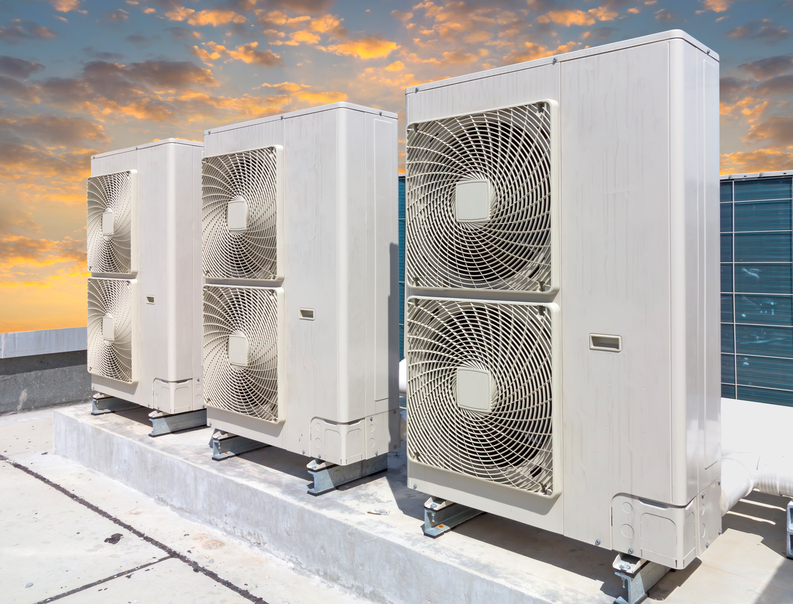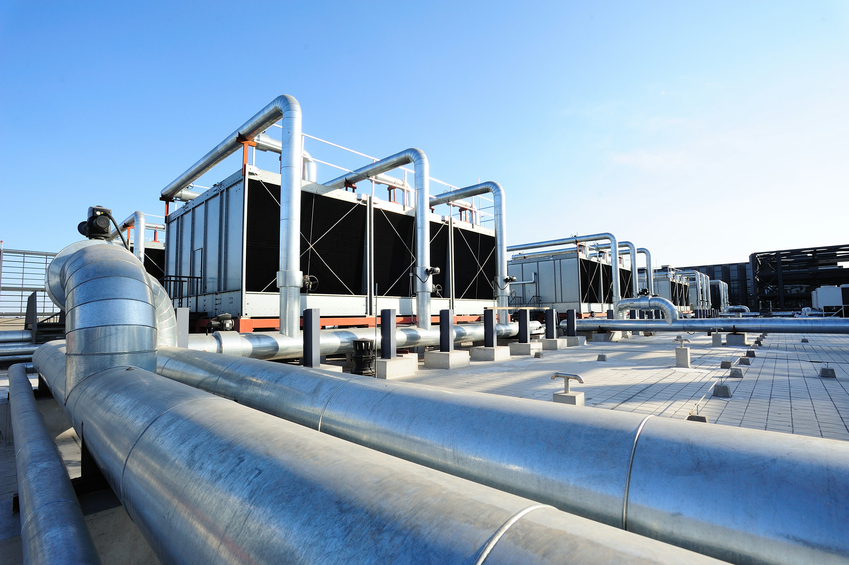HVAC Systems 12 PDH Discount Package
Hydronic Systems (M04-008)
Overview of Chiller Compressors (M04-027)

This online engineering PDH course discusses the applications of chiller systems.
A chiller can be generally classified as a refrigeration system that uses either a vapor compression or absorption cycle to cool. Both the absorption and the mechanical compression systems have the evaporation and condensation of a refrigerant in common. In both systems, the refrigerant evaporates at low pressure to absorb heat and then condenses at higher pressure to reject heat to the atmosphere. Both systems require energy to raise the temperature of the refrigerant for the heat rejection process.
The difference is that the mechanical chillers use reciprocating, centrifugal or screw compressors that are powered by electric motors whereas in the absorption cycle uses heat (usually steam or direct fire) to raise the refrigerant temperature. Mechanical chillers are most commonly used in residential and commercial buildings whereas absorption systems offer an excellent choice for industrial applications there waste heat recovery is an essential element of the process.
This 4 PDH online course is applicable to mechanical engineers, design and construction personnel, technical staff and facility personnel who are interested in gaining a better understanding of chiller systems.
This PE continuing education course is intended to provide you with the following specific knowledge and skills:
- How the mechanical compression cycle operates
- What are the different types of mechanical compressors
- What is vapor absorption refrigeration cycle, its components and applications
- What do the terms efficiency and coefficient of performance mean
- What are the functions of the different components of a chiller system
- How is heat rejection achieved through contact and non-contact type cooling towers
- What are the different types of refrigerants and their effects on environment
- What are the principle guidelines in sizing, costing and selecting an appropriate chiller
- Why is water treatment important in closed and open systems
- What are the basic methods and procedures for testing, adjusting and balancing (TAB) of chiller systems
In this professional engineering CEU course, you need to review Appendix C, "Chiller Systems" of the US Corps of Engineers Construction Engineering Research Laboratory (USACERL) technical report 99/20, May 1999.
Upon successful completion of the quiz, print your Certificate of Completion instantly. (Note: if you are paying by check or money order, you will be able to print it after we receive your payment.) For your convenience, we will also email it to you. Please note that you can log in to your account at any time to access and print your Certificate of Completion.

This online engineering PDH course provides basics of the hydronic system operation and will familiarize the reader with piping system layout and operation, as well as provide an awareness of common circuiting arrangements. Topics to be discussed include auxiliary hydronic system components such as pumps, expansion tank, terminal units, distribution piping and fittings.
The circulation of hot water or chilled water to provide heat or cool the spaces is known as "Hydronic" system. It is a closed system where cold or hot water/steam runs through a heat exchanger and air is then blown over the heat exchanger to get the desired room conditions. Traditionally, HVAC systems are designed as All-Air Systems, which means that air is cooled at one location and is than distributed to the required space through ducts. All-Air Systems achieve the task of cooling a building by convection only. Hydronic system provides an alternative to cool/heat through a combination of radiation and convection inside the building.
Hydronic heating has three advantages over other types of heating systems. These advantages are comfort, efficiency, and versatile installation. With hydronics, you can move 40,000 Btu's through a 3/4" copper pipe through walls and between floors - or anywhere you need the heat - quietly and efficiently. A forced air system requires a lot of duct space, about an 8" by 14" duct, to move that much air with that many Btu's into a room.
This 4 PDH online course is applicable to mechanical engineers, design and construction personnel, technical staff and facility personnel who are interested in gaining a better understanding of hydronic systems.
This PE continuing education course is intended to provide you with the following specific knowledge and skills:
- Understand the basic hydronic systems in heating and cooling applications
- Understand the difference between once through, recirculation, open and closed systems
- Describe the components of hydronic systems such as air separators, air vents, circulators, relief valves, expansion tanks, flow control devices, miscellaneous valve and fittings
- Understand water system piping classification for main and branch feeders
- Learn about the various piping circuits including one pipe, two pipe, three pipe and four pipe systems for various applications
- Understand different type of heating and cooling terminal units such as unitary equipment, air handling units, baseboard heaters, convectors and radiators
- Learn different type of hydronic pumps including circulators, closed coupled centrifugal pumps and horizontal split casing pumps
- Understand pump cavitation and pump installation considerations; parallel or series arrangement
- Learn basic hydronic system testing, adjusting and balancing (TAB) procedures
In this professional engineering CEU course, you need to review Appendix E, "Hydronic Systems" of the US Corps of Engineers Construction Engineering Research Laboratory (USACERL) technical report 99/20, May 1999.
Upon successful completion of the quiz, print your Certificate of Completion instantly. (Note: if you are paying by check or money order, you will be able to print it after we receive your payment.) For your convenience, we will also email it to you. Please note that you can log in to your account at any time to access and print your Certificate of Completion.

This online engineering PDH course provides comprehensive information on the chiller compressors. It addresses the key issues pertaining to the chiller compressor selection and their applications. The practical considerations and assessment criterion are also discussed in brief.
In HVAC industry, the refrigeration machine that produces chilled water is referred to as a "chiller". The majority of installations operating worldwide are based on the vapor compression chillers that use mechanical energy in the form of electric motor to drive the cooling cycle. The vapor compression chiller packages are generally classified by 4 types of compressors namely centrifugal, reciprocating, screw and scroll.
This 4 PDH online course is applicable to HVAC engineers, facility engineers, architects, environmentalists, operations and maintenance personnel, as well as consultants and contractors who construct, build and manage facilities.
This PE continuing education course is intended to provide you with the following specific knowledge and skills:
- Operating principle of reciprocating, screw, centrifugal and scroll compressors
- Key advantages, disadvantages, limitations and drawbacks of various refrigeration compressors
- Efficiency ratings of various chiller options on peak load and part load
- Factors affecting the efficiency of chiller compressors
- Types of refrigerants used/recommended
- Heat rejection options - air cooled vs. water cooled chillers
- Reliability, maintenance, field serviceability of various chiller options
- ARI standard 550/590 performance standard for defining part load performance ratings - IPLV vs. NPLV
- Importance of peak load and part load analysis in determining the overall capacity and number of chillers
- Series and parallel arrangement of chillers
- Operational regimes, infrastructural availability and physical attributes affecting the selection of chillers
- Procurement strategies, performance specifications, life cycle cost considerations
In this professional engineering CEU course, you need to review the document titled, "Overview of Compressor Chillers".
Upon successful completion of the quiz, print your Certificate of Completion instantly. (Note: if you are paying by check or money order, you will be able to print it after we receive your payment.) For your convenience, we will also email it to you. Please note that you can log in to your account at any time to access and print your Certificate of Completion.